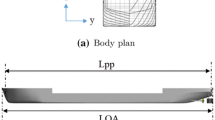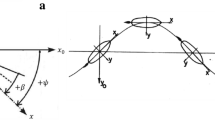Abstract
While passing through a lock, a ship usually undergoes a steady forward motion at low speed. Owing to the size restriction of lock chamber, the shallow water and bank effects on the hydrodynamic forces acting on the ship may be remarkable, which may have an adverse effect on navigation safety. However, the complicated hydrodynamics is not yet fully understood. This paper focuses on the hydrodynamic forces acting on a ship passing through a lock. The unsteady viscous flow and hydrodynamic forces are calculated by applying an unsteady RANS code with a RNG k-ɛ turbulence model. User-defined function (UDF) is compiled to define the ship motion. Meanwhile, the grid regeneration is dealt with by using the dynamic mesh method and sliding interface technique. Numerical study is carried out for a bulk carrier ship passing through the Pierre Vandamme Lock in Zeebrugge at the model scale. The proposed method is validated by comparing the numerical results with the data of captive model tests. By analyzing the numerical results obtained at different speeds, water depths and eccentricities, the influences of speed, water depth and eccentricity on the hydrodynamic forces are illustrated. The numerical method proposed in this paper can qualitatively predict the ship-lock hydrodynamic interaction. It can provide certain guidance on the manoeuvring and control of ships passing through a lock.
Similar content being viewed by others
References
Ch’ng, P. W., Doctors, L. J. and Renilson, M. R., 1993. A method of calculating the ship-bank interaction forces and moments in restricted water, International Shipbuilding Progress, 40(421): 7–23.
Delefortrie, G., Willems, M., Laforce, E., Vantorre, M., De Mulder, T., De Regge, J. and Wong, J., 2008. Tank test of vessel entry and exit for third set of Panama locks, Proceedings of International Navigation Seminar Following PIANC AGA 2008, Beijing, China Communications Press, 517–523.
Delefortrie, G., Willems, M., Vantorre, M. and Laforce, E., 2009. Behavior of post panamax vessels in the Third Set of Panama locks, Proceedings of MARSIM’09, International Conference on Marine Simulation and Ship Maneuverability, Panama City, Panama.
De Mulder, T., 2009. Paper 7-Mooring forces and ship behaviour in navigation locks, Proceedings of International Workshop on Innovations in Navigation Lock Design, Brussels, Belgium, 1–3.
Li, D. Q., Ottosson, P. and Trägårdh, P., 2003. Prediction of bank effects by model tests and mathematical models, Proc. MARSIM’03, International Conference on Marine Simulation and Ship Maneuverability, Kanazawa, Japan, RC30.1-12.
Norrbin, N. H., 1974. Bank effects on a ship moving through a short dredged channel, Proceedings of the 10th Symposium on Naval Hydrodynamics, Cambridge, USA, 71–87.
Van Kerkhove, G., Vantorre, M. and Delefortrie, G., 2009. Advanced model testing techniques for ship behaviour in shallow and confined water, Proceedings of the 1st International Conference on Advanced Model Measurement Technology for the EU Maritime Industry (AMT’09), Nantes, France, 158–172.
Vantorre, M., Delefortrie, G. and Mostaert, F., 2012. Behaviour of Ships Approaching and Leaving Locks: Open Model Test Data for Validation Purposes, Version 2.0, WL Rapporten, WL2012R815_08e, Flanders Hydraulics Research and Ghent University, Antwerp, Belgium.
Versteeg, H. K. and Malalasekera, W., 1995. An Introduction to Computational Fluid Dynamics: The Finite Volume Method, Wiley, New York.
Verwilligen, J., Richter, J., Reddy, D., Vantorre, M. and Eloot, K., 2012. Analysis of full ship types in high-blockage lock configurations, Proceedings of International Conference on Marine Simulation and Ship Maneuverability (MARSIM’12), 1–9.
Vrijburcht, A., 1988. Calculations of Wave Height and Ship Speed When Entering A Lock, PUB-391, Delft Hydraulics Laboratory.
Wang, H. M., 2009. Numerical Study on the Viscous Flow and Hydrodynamic Forces on A Manoeuvring Ship in Restricted Waters, Ph. D. Thesis, Shanghai Jiao Tong University, Shanghai, China. (in Chinese)
Yakhot, V. and Orszag, S. A., 1986. Renormalization group analysis of turbulence. I. Basic theory, Journal of Scientific Computing, 1(1): 3–51.
Author information
Authors and Affiliations
Corresponding author
Additional information
This work was financially supported by the National Natural Science Foundation of China (Grant Nos. 51061130548 and 51179019).
Rights and permissions
About this article
Cite this article
Wang, Hz., Zou, Zj. Numerical prediction of hydrodynamic forces on a ship passing through a lock. China Ocean Eng 28, 421–432 (2014). https://doi.org/10.1007/s13344-014-0034-3
Received:
Revised:
Accepted:
Published:
Issue Date:
DOI: https://doi.org/10.1007/s13344-014-0034-3




